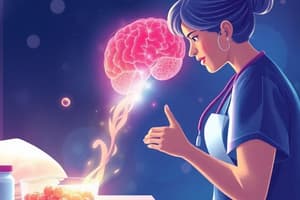Podcast
Questions and Answers
What is the rate-limiting step in the Renin-Angiotensin-Aldosterone System (RAAS)?
What is the rate-limiting step in the Renin-Angiotensin-Aldosterone System (RAAS)?
- Release of aldosterone from the adrenal glands
- Release of renin from the juxtaglomerular cells of the kidney (correct)
- Conversion of angiotensin I to angiotensin II
- Activation of the sympathetic nervous system
What is the mechanism of action of Aliskiren?
What is the mechanism of action of Aliskiren?
- Blocks the action of ACE
- Direct renin inhibitor (correct)
- Stimulates the release of aldosterone
- Converts angiotensin I to angiotensin II
What is a common side effect of ACE inhibitors?
What is a common side effect of ACE inhibitors?
- Hypertension
- Hyperkalemia (correct)
- Hypernatremia
- Hypoglycemia
What is the main mechanism of action of ACE inhibitors that contributes to their therapeutic effects?
What is the main mechanism of action of ACE inhibitors that contributes to their therapeutic effects?
What is the indication for using ACE inhibitors?
What is the indication for using ACE inhibitors?
Which of the following is a common indication for the use of ACE inhibitors?
Which of the following is a common indication for the use of ACE inhibitors?
What is a contraindication for the use of ACE inhibitors?
What is a contraindication for the use of ACE inhibitors?
Which of the following is a common side effect associated with the use of ACE inhibitors?
Which of the following is a common side effect associated with the use of ACE inhibitors?
What is the main mechanism of action of angiotensin II receptor blockers (ARBs)?
What is the main mechanism of action of angiotensin II receptor blockers (ARBs)?
What is the primary mechanism by which beta blockers reduce blood pressure in hypertension?
What is the primary mechanism by which beta blockers reduce blood pressure in hypertension?
What is the main mechanism of action of nonspecific alpha blockers like phentolamine?
What is the main mechanism of action of nonspecific alpha blockers like phentolamine?
Which of the following is a common indication for the use of nonspecific alpha blockers?
Which of the following is a common indication for the use of nonspecific alpha blockers?
What is the mechanism of action of alpha 1 blockers?
What is the mechanism of action of alpha 1 blockers?
Which of the following is a common drug in the class of nonspecific alpha blockers?
Which of the following is a common drug in the class of nonspecific alpha blockers?
How do ACE inhibitors lower blood pressure?
How do ACE inhibitors lower blood pressure?
Which of the following is a common side effect of ACE inhibitors?
Which of the following is a common side effect of ACE inhibitors?
What is an indication for using ACE inhibitors?
What is an indication for using ACE inhibitors?
Which statement is a contraindication for using ACE inhibitors?
Which statement is a contraindication for using ACE inhibitors?
How do ARBs differ in mechanism of action from ACE inhibitors?
How do ARBs differ in mechanism of action from ACE inhibitors?
What is the primary mechanism of action of carbonic anhydrase inhibitors?
What is the primary mechanism of action of carbonic anhydrase inhibitors?
Which of the following are common indications for carbonic anhydrase inhibitors?
Which of the following are common indications for carbonic anhydrase inhibitors?
What is the primary mechanism of action of loop diuretics?
What is the primary mechanism of action of loop diuretics?
Which of the following are common side effects of loop diuretics?
Which of the following are common side effects of loop diuretics?
What is the primary mechanism of action of thiazide diuretics?
What is the primary mechanism of action of thiazide diuretics?
Flashcards are hidden until you start studying
Study Notes
ACE Inhibitors
- Indications: hypertension, heart failure, and diabetic nephropathy
- Contraindications: pregnancy and bilateral renal artery stenosis
- Common side effects: cough, hyperkalemia
- Common drugs: lisinopril, enalapril, ramipril
- Bradykinin: a vasodilator, plays a role in reducing blood pressure and causes cough as a side effect
Angiotensin II Receptor Blockers (ARBs)
- Mechanism of action: block the action of angiotensin II at its receptor sites, leading to vasodilation and decreased aldosterone release
- Indications: hypertension, heart failure
- No dry cough or angioedema due to no effect on bradykinin levels
- Common drugs: losartan, valsartan, irbesartan
Angiotensin II (Ang II)
- Potent vasoconstrictor that increases blood pressure by constricting blood vessels and stimulating aldosterone release
- Dual action helps to lower blood pressure by reducing peripheral vascular resistance
Nebivolol
- Mechanism of action: stimulates the release of nitric oxide from the endothelium, leading to vasodilation and decreased blood pressure
- Nitric oxide relaxes the smooth muscle in blood vessels, leading to vasodilation
Centrally-acting Sympathetic Agents
- Mechanism of action: reduce sympathetic outflow from the brain, leading to a decrease in heart rate and blood pressure
- Common drugs: clonidine, methyldopa
Reserpine
- Mechanism of action: blocks the uptake of norepinephrine and dopamine into storage vesicles in sympathetic nerve terminals, leading to reduced sympathetic activity and decreased blood pressure
Carbonic Anhydrase Inhibitors
- Mechanism of action: block the enzyme carbonic anhydrase in the proximal convoluted tubule of the kidney, leading to decreased reabsorption of bicarbonate and sodium, resulting in metabolic acidosis
- Common indications: glaucoma, altitude sickness
- Common drugs: acetazolamide, dorzolamide
Loop Diuretics
- Mechanism of action: inhibit the reabsorption of sodium and chloride in the loop of Henle, leading to increased urine output
- Common indications: heart failure, hypertension, edema
- Side effects: metabolic alkalosis, hyponatremia, hypokalemia, hyperglycemia, hypocalcemia
- Common drugs: furosemide, torsemide, bumetanide
Thiazide Diuretics
- Mechanism of action: inhibit the reabsorption of sodium and chloride in the distal convoluted tubule, leading to increased urine output
- Common indications: hypertension, edema
- Side effects: metabolic alkalosis, hyponatremia, hypokalemia, hyperglycemia, hypercalcemia
- Common drugs: hydrochlorothiazide, chlorothiazide
Renin-Angiotensin-Aldosterone System (RAAS)
- Regulates blood pressure and fluid balance in the body
- Rate-limiting step: release of renin from the juxtaglomerular cells of the kidney
- Factors that stimulate the release of renin: decreased blood pressure, decreased sodium levels, sympathetic nervous system activation
- Renin acts on angiotensinogen to produce angiotensin I, which is converted to angiotensin II by ACE
Aliskiren
- Mechanism of action: direct renin inhibitor, blocks the conversion of angiotensinogen to angiotensin I, inhibiting the RAAS system
- Side effects: diarrhea, cough, hyperkalemia
Beta Blockers
- Mechanism of action: block beta 1 receptors in the heart, leading to decreased heart rate and contractility, reducing cardiac output and blood pressure
- Block beta 1 receptors in the kidney, reducing renin release and production of angiotensin II
- Common drugs: propranolol, metoprolol, atenolol
Nonspecific Alpha Blockers
- Mechanism of action: block both alpha 1 and alpha 2 receptors, leading to vasodilation and decreased blood pressure
- Indications: pheochromocytoma, hypertensive emergencies
- Common drugs: phentolamine
Alpha 1 Blockers
- Mechanism of action: block alpha 1 receptors, leading to vasodilation and decreased blood pressure
- Indications: hypertension, benign prostatic hyperplasia
- Common drugs: prazosin, doxazosin
Studying That Suits You
Use AI to generate personalized quizzes and flashcards to suit your learning preferences.




